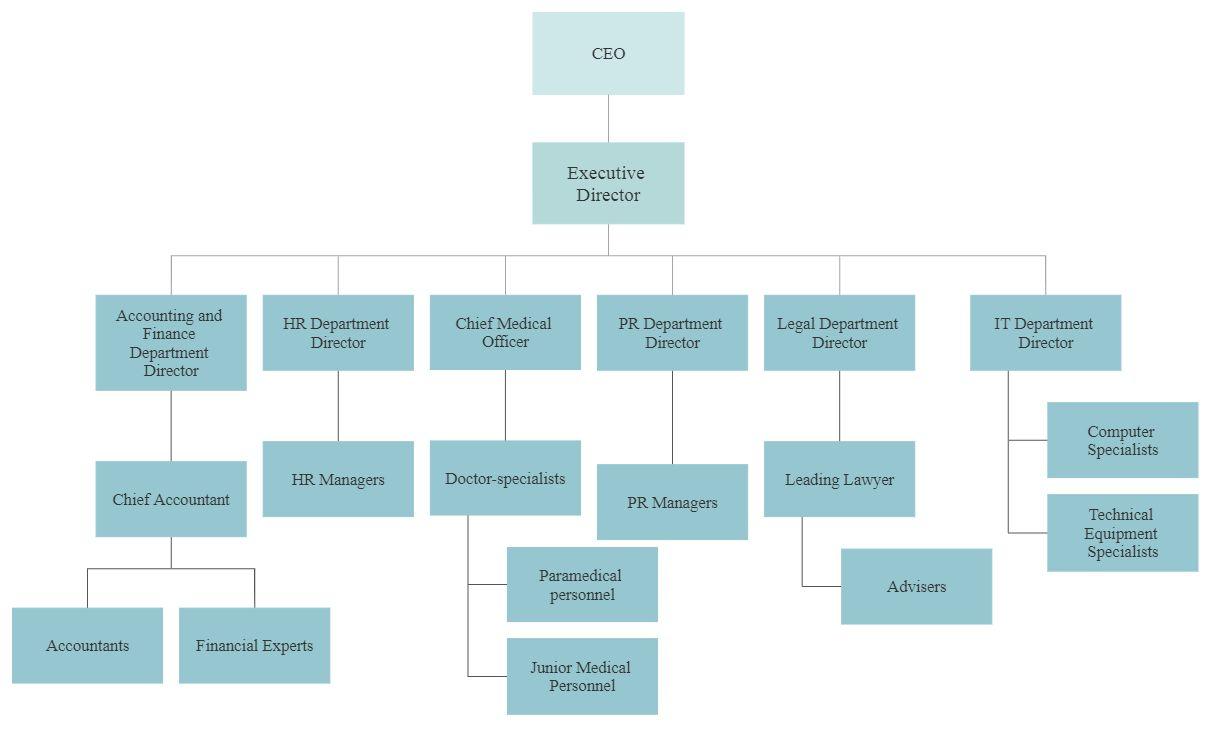Organizational structure is a system that reflects how activities are managed in order to achieve a company’s goals. The arrangement outlines the distribution of duties and roles in an organization. The current essay describes the organizational structure and the organizational chart of the private medical company that provides services in the field of laboratory diagnostics. The paper also focuses on formal and informal leadership issues and suggests two practices that could be useful for the firm.
The organizational structure of the company belongs to the functional type. The key idea of this structure is the division of the company into separate groups with particular duties. Each department has a director who is answerable to the executive director. The latter, in their turn, is accountable to the CEO. The company is composed of six departments that are listed in the organizational chart in the appendix section. In some cases, the heads of departments control the chief managers who lead ordinary employees. In other cases, the directors of the subdivisions immediately supervise the workers. The mentioned variety depends on the size of a department. For instance, HR managers are answerable directly to the HR department director, while the nurses are supervised by doctors who are controlled by the chief medical officer.
The crucial advantage of such a system is a strict division of responsibilities and the absence of the duplication of tasks. The neoclassical organizational theory entirely supports the presented organizational system of the clinic. This theory emphasizes the importance of individuals for the total productivity of a company. Compared with the classical approach, this one pays attention to the requirements and needs of employees; they are not viewed as identical cogs in the company’s machinery. Staff members are divided according to their skills and interests. Additionally, employees might influence the company’s decision-making process since they could communicate with the company’s administration via senior managers and directors of the departments.
Formal leadership stems from power and focuses on the control of the working process. Its main objective is the effective management of the employees and the achievement of the specified goals. An example of formal leadership in the private clinic is the accountability of nurses to the physicians. Nurses must fill out reports on their activities and obtain the approval of the doctors for various purposes. Informal leadership relates to relationships and influence. Informal leaders commonly have a broad circle of contacts in a company. Personal nursing practice suggests that experienced nurses sometimes become informal leaders. They create an atmosphere of trust in the team, assist newcomers, and doctors reckon with their opinion. Informal leadership mainly has a favorable influence on the working process since such people become the soul of a team and mediator between directors and employees. Besides, the formal leader prevents the informal one from the abuse of authority.
The practices that could be used by the private medical company include the integration of social initiatives into the working practice and the leadership development for the nurses. Imperatori (2017) argues that social actions affect the performance of employees since they become more motivated. Employees that are not engaged in patient care could become more inspired via participation in social initiatives. Beal and Riley (2019) suggest increasing leadership development training for nurses. Thus, they could quire inter-professional experience and later become formal leaders of a company and even chief medical officers. It is beneficial because such nurses have an excellent knowledge of working in the clinic and know how to administrate it.
In conclusion, the private medical company being observed has a functional type of organizational structure. The allocation of duties and responsibilities is justified by the neoclassical theory that emphasizes the significance of employees as individuals. The company has both formal and informal leaders, and thus it is highly advised to train nurses so that they could become directors and manage a clinic. Finally, employees of other departments would become more committed to their job via engagement in the social projects that relate to the company.
References
Beal, J. A., & Riley, J. M. (2019). Best organizational practices that foster scholarly nursing practice in Magnet® hospitals. Journal of Professional Nursing, 35(3), 187-194.
Imperatori, B. (2017). Engagement and disengagement at work: Drivers and organizational practices to sustain employee passion and performance. Springer.
